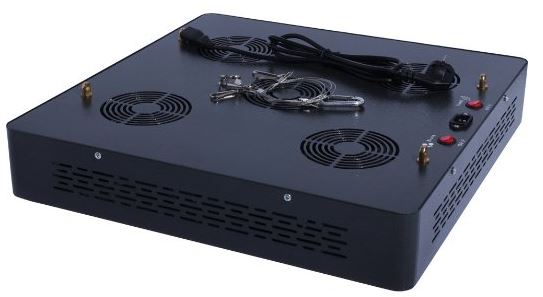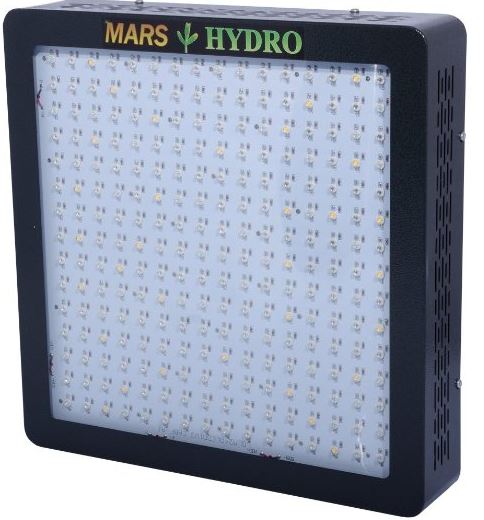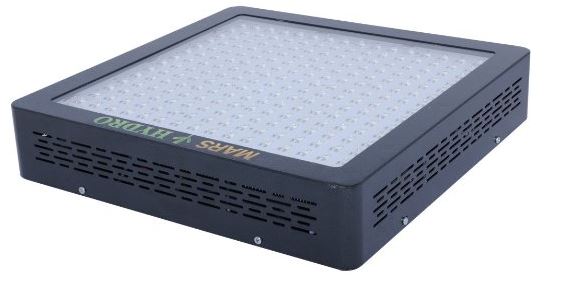Mars Hydro MARS II LED Grow Light Review
Growing with LEDs can be a fun, exciting, and very rewarding, but it has more of an upfront cost than growing with standard fluorescent or HID lights. The initial investment it takes to grow with LEDs often skews people away from growing with them. Most growers need to set an appropriate budget and go from there. However, don’t be too disappointed because there are still some very high quality LED grow lights that don’t necessarily cost an arm and a leg.
Take the Mars Hydro MARS II series of LED grow lights for example. With a wide range of fixtures ranging from 400 watts to 1600 watts, there’ seems to be a sufficient panel for every scenario whether you’re growing tomatoes, peppers, micro greens, or other veggies. Since they offer such a range of lights, it also means that you’re given the flexibility to pick and choose which power, strength, or wattage your indoor garden needs. No matter if you’re flowering, vegging, or simply trying to sprout seedlings or clones, the Mars Hydro MARS II series makes an excellent choice.
Multiple Sizes for Multiple Scenarios
- Mars II 400 = 80 x 5w diodes.
- Mars II 700 = 140 x 5w diodes.
- Mars II 900 = 180 x 5w diodes.
- Mars II 1200 = 240 x 5w diodes.
- Mars II 1600 = 324 x 5w diodes.
As you can see in the list above, the larger panel you use, the more diodes or “individual LEDs” there are. Since there are more diodes on the larger sized panels, they give off more light as they increase in size or wattage. However, do keep in mind that the advertised wattage isn’t necessarily the same amount of energy or wattage that it will pull from the wall when plugged into a power outlet. This is because the diodes are never driven at their maximum level which ensures longevity and lasting quality for years to come. If the diodes were driven to their maximum, yes it would give off more light, but it simply isn’t a good thing. Too much power being driven to the diodes will leave you with a broken or dead panel that won’t even turn on. Luckily Mars Hydro though this through and paired them with a great amount of efficiency.

Actual Power Consumption
As we just previously discussed, the wattage of the panel doesn’t necessarily mean it’s going to deliver that much wattage. After all, wattage is a electrical term, and plants don’t use electricity to grow, they use light of different wavelengths at certain PAR readings. Although Mars Hydro doesn’t list the PAR readings, they do list the actual wattage of each panel:
- Mars II 400 = 190-206 watts.
- Mars II 700 = 325-340 watts.
- Mars II 900 = 440-445 watts.
- Mars II 1200 = 570-595 watts.
- Mars II 1600 = 735-755 watts.
As you can see, each panel tends to use about half of what it’s rated for. This is actually a good thing. Not only does it boost the longevity of the fixture itself, it assures that the plants in your garden are given an evenly distributed amount of energy so the pattern of light is as uniform as possible.
Recommended Coverage
As with any grow light or growing setup, you’re limited to the amount of effective space that each panel can provide. As the panels get larger, they increase in coverage so you can fit more plants under a single lamp than the size before it. To give a more accurate representation of each panel and their footprint of effective coverage, take a look on how it differs from each panel.
- Mars II 400 = 2.5 feet x 2.5 feet.
- Mars II 700 = 3 feet x 3 feet.
- Mars II 900 = 3.5 feet x 3.5 feet.
- Mars II 1200 = 4 feet x 4 feet.
- Mars II 1600 = 4.2 feet x 4.2 feet.
Although the coverage is about standard for the size of each panel, you need to keep in mind that with flowering, your garden will require ample light coverage to properly bloom. Vegging requires a bit less of intensity so you can likely get away with a Mars II 1600 in a 5 foot x 5 foot area if all you plan to do is vegging, grow seedlings, or clone/propagate plants. However, if you want real results when you decide to bloom, stick to the recommended coverage as listed above, or even go slightly smaller than recommended.

Spectrum
As with any grow light, the spectrum is a huge and very important factor that must be taken into consideration. Luckily, Mars Hydro seems to know what they’re doing since they equipped their series of panels with a 10 band full spectrum for even and properly distributed light. The diodes are comprised of a blend of 10 different bands that include 430~440nm, 450~475nm 620~630nm, 650~660nm, IR, and white. Keep in mind that the infrared diodes will not emit any visible light the the human eye. These IR diodes may even appear defective at first, but just know that it’s because humans aren’t able to see infrared.
Cooling and Heat
The most popular misconception when growing with LEDs is that they don’t produce any heat. This is simply wrong and a huge understatement. While it’s true that they produce much less heat that standard lighting technologies like fluorescent, HPS, and MH, they still produce a fair amount of heat that needs to be properly managed. Mars Hydro built their panels with an appropriate amount of heatsinks and internal fans that constantly make sure everything is operating within the most efficient temperatures. Whenever you turn the light on, the cooling system is hard at work to maintain an appropriate temperature range for optimal operation.
Final Thoughts
Although Mars Hydro doesn’t list the PAR or the specific brands of parts they use, it seems they’ve created an excellent, affordable, and budget-friendly option for those who want to grow with LEDs but don’t want to spend an arm and a leg. The Mars Hydro Mars II is equipped with a massive amount of 5 watt diodes that are all under driven, you can expect each panel to last around 50,000 to 100,000 hours without any failure. Additionally, they’ve packaged each of their lights with a one year manufacturers warranty to keep a strong guarantee for the first 12 months of ownership. Overall, they offer decent lights at decent prices.









I have $1000 budget and a 4 foot by 4 foot space,I am looking for an energy efficient led light, what would you recommend for this budget?
Four of these should do the trick – http://amzn.to/1UqE3Vd
The Mars Hydro ll 900, because this particular light will cover the Foley area you only need one of them anything stronger than that it won’t even fit in your space if you look at the dimensions of the suggested lights too big to have 4 of them and that’s just too much anyway you need one that fits decently is not too much for the space and will be efficient I suggested what will cover a 4 by 4 area with no loss of penetration or Spectrum intensity from edge to edge it will like that 4 by 4 space very much you will have full intensity edge-to-edge I use the 700 series in a 3 by 3 grow area and I have tremendous results
Thanks